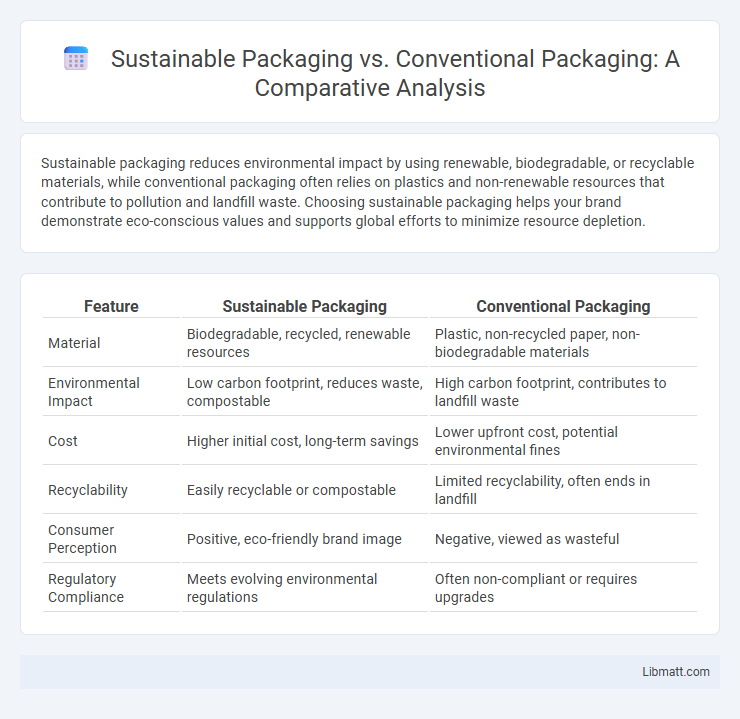Sustainable packaging reduces environmental impact by using renewable, biodegradable, or recyclable materials, while conventional packaging often relies on plastics and non-renewable resources that contribute to pollution and landfill waste. Choosing sustainable packaging helps your brand demonstrate eco-conscious values and supports global efforts to minimize resource depletion.
Table of Comparison
| Feature | Sustainable Packaging | Conventional Packaging |
|---|---|---|
| Material | Biodegradable, recycled, renewable resources | Plastic, non-recycled paper, non-biodegradable materials |
| Environmental Impact | Low carbon footprint, reduces waste, compostable | High carbon footprint, contributes to landfill waste |
| Cost | Higher initial cost, long-term savings | Lower upfront cost, potential environmental fines |
| Recyclability | Easily recyclable or compostable | Limited recyclability, often ends in landfill |
| Consumer Perception | Positive, eco-friendly brand image | Negative, viewed as wasteful |
| Regulatory Compliance | Meets evolving environmental regulations | Often non-compliant or requires upgrades |
Introduction to Sustainable vs Conventional Packaging
Sustainable packaging uses eco-friendly materials designed to minimize environmental impact through recyclability, biodegradability, and reduced carbon footprint, while conventional packaging often relies on non-renewable resources like plastics and metals that contribute to pollution and waste. Your choice between sustainable and conventional packaging directly affects resource conservation, waste management, and brand perception in an increasingly eco-conscious market. Embracing sustainable packaging supports circular economy principles and long-term environmental health compared to traditional packaging methods.
Defining Sustainable Packaging
Sustainable packaging refers to materials and design methods that minimize environmental impact by using renewable, recyclable, or biodegradable resources while reducing waste and carbon footprint. Unlike conventional packaging, which often relies on non-renewable plastics and generates significant landfill waste, sustainable packaging prioritizes lifecycle assessments and circular economy principles. This approach supports resource conservation, reduces pollution, and promotes eco-friendly alternatives in product delivery systems.
Key Features of Conventional Packaging
Conventional packaging primarily relies on non-renewable materials such as plastics, metals, and glass, which often contribute to environmental pollution due to limited recyclability and prolonged decomposition times. These packages typically emphasize cost-effectiveness and durability but lack eco-friendly attributes like biodegradability or reduced carbon footprint. Understanding the key features of conventional packaging helps you evaluate the trade-offs between immediate functionality and long-term sustainability goals.
Environmental Impact Comparison
Sustainable packaging significantly reduces environmental impact by utilizing biodegradable, recycled, or renewable materials that minimize waste and lower carbon emissions compared to conventional packaging, which often relies on non-recyclable plastics and resource-intensive production processes. Lifecycle assessments reveal that sustainable options decrease pollution and energy consumption throughout production, usage, and disposal stages, contributing to a smaller ecological footprint. By choosing sustainable packaging, You help preserve natural resources and reduce landfill accumulation, fostering a more eco-friendly supply chain.
Material Sources and Production Methods
Sustainable packaging utilizes renewable, biodegradable, or recycled materials such as plant-based bioplastics, paper, and cardboard, minimizing environmental impact through lower carbon emissions and reduced waste generation. In contrast, conventional packaging primarily relies on petroleum-based plastics and non-renewable resources, with energy-intensive production processes that contribute significantly to pollution and resource depletion. Advanced production methods in sustainable packaging emphasize eco-friendly practices like low-energy manufacturing, waterless printing, and closed-loop recycling systems to enhance material efficiency and lifecycle sustainability.
Cost Analysis: Sustainable vs Conventional
Sustainable packaging often involves higher upfront costs due to eco-friendly materials and innovative design processes, but it can reduce long-term expenses through improved efficiency and waste reduction. Conventional packaging typically offers lower initial costs but may incur hidden expenses related to environmental impact, regulatory compliance, and disposal fees. Your choice between sustainable and conventional packaging should weigh immediate budget constraints against potential savings and brand value from sustainable practices.
Consumer Perceptions and Preferences
Sustainable packaging is increasingly favored by consumers who prioritize environmental responsibility and seek products with eco-friendly credentials, reflecting growing awareness of climate impact. Research shows that many buyers perceive sustainable packaging as higher quality and are willing to pay a premium, influencing brand loyalty and purchase decisions. Your choice of packaging can significantly affect consumer preference, driving demand for recyclable, biodegradable, or reusable materials over conventional plastic and non-renewable options.
Regulatory and Industry Trends
Sustainable packaging is increasingly mandated by regulatory frameworks such as the EU's Single-Use Plastics Directive and the U.S. EPA's Sustainable Materials Management programs, driving industries to adopt eco-friendly materials and practices. Industry trends emphasize the shift towards biodegradable, recyclable, and reusable packaging solutions to meet consumer demand and compliance requirements. Your business can benefit from aligning with these regulations to reduce environmental impact and stay competitive in markets prioritizing sustainability.
Challenges in Adoption and Implementation
Sustainable packaging faces significant challenges in adoption and implementation, including higher initial costs, limited material availability, and lack of standardized regulations compared to conventional packaging. Companies must overcome supply chain complexities and invest in research to ensure sustainable materials meet performance requirements. Your business can benefit from gradually integrating eco-friendly packaging by leveraging government incentives and consumer demand for green products.
Future Outlook for Packaging Solutions
Sustainable packaging is rapidly evolving as the preferred choice for environmentally conscious businesses seeking to reduce carbon footprints and waste. Innovations in biodegradable materials, reusable designs, and minimalistic approaches are set to dominate the future packaging landscape, offering scalable solutions that meet regulatory demands and consumer preferences. Your commitment to adopting sustainable packaging can enhance brand reputation while aligning with global efforts toward a circular economy and resource conservation.
Sustainable packaging vs conventional packaging Infographic

 libmatt.com
libmatt.com